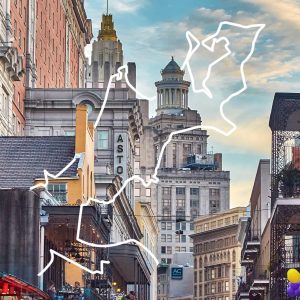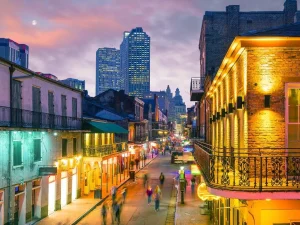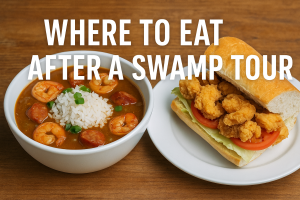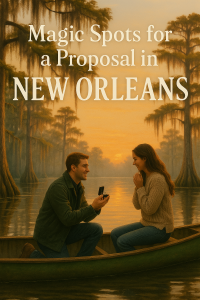
Emerging Indie Spots in NOLA
New Orleans is known for its jazz clubs, historic architecture, and legendary food—but there’s another side to the city that’s growing rapidly. Away from Bourbon Street and the big-name attractions, you’ll find a collection of small, independent businesses, galleries, and hangouts shaping the city’s future. In this guide to emerging indie spots in NOLA, we’ll explore the latest creative corners, community-driven cafés, and even a swamp tour with a local twist. If you want to see a fresher, more authentic version of the Crescent City, these are the places to put on your list. Coffee Shops That Double as Creative Hubs A good coffee shop in New Orleans is more than a place to grab a latte—it’s a stage for the city’s creativity. When looking for Independent spots in NOLA, check out: These spots are perfect for starting your day, especially if you’re planning to explore the rest of the city’s indie scene. Indie Food and Drink Experiences New Orleans is a food city, and emerging indie spots in NOLA are bringing bold, inventive flavors to the table. Pair one of these meals with a locally brewed beer from Parleaux Beer Lab, an alternative brewery in Bywater with a constantly rotating tap list and a vibrant beer garden. Art Galleries Off the Beaten Path If you’re drawn to creativity, the indie art scene in New Orleans will not disappoint. Part of emerging indie spots in NOLA includes small, artist-run galleries that double as performance spaces and cultural hubs. Visiting these galleries offers a deeper look into the city’s creative spirit, far from the souvenir shops. An Indie Approach to the Swamp Tour Even nature lovers can find emerging indie spots in NOLA—and yes, that includes swamp tours. While large commercial tours dominate, a handful of smaller, independently owned operators are offering eco-conscious, personalized experiences. These swamp tours often use smaller boats to navigate narrow bayou channels, giving you a closer look at the wildlife and plant life. The captains are usually locals who grew up in the area, blending storytelling, history, and environmental education. Some even partner with local chefs to offer dockside meals after the tour, creating a one-of-a-kind day trip that blends adventure with flavor. Shopping Local in Hidden Corners New Orleans’ indie spirit thrives in its small boutiques and maker markets. As you continue your tour of emerging indie spots in NOLA, check out: Final Thoughts Emerging indie spots in NOLA capture the city’s creative, rebellious spirit in a way no chain or corporate attraction ever could. From cozy coffee shops and experimental art galleries to intimate swamp tours and microbreweries, the city’s scene is constantly evolving. The next time you visit New Orleans, skip the usual checklist and immerse yourself in its thriving independent culture—you might just discover your new favorite place.

Exploring NOLA as a Local
New Orleans isn’t just a tourist destination—it’s a way of life. From second-line parades to neighborhood po’boy spots, the Crescent City has a heartbeat that only locals truly feel. If you’re looking to step off the beaten path and see what the city is really about, this guide to exploring NOLA as a local will show you how to do it right. Whether you’re a first-time visitor who wants to skip the tourist traps or a longtime resident looking to fall back in love with the city, here’s how to experience New Orleans through the eyes of a local—including how to enjoy a swamp tour without the crowds. Start the Day Like a Local: Coffee and Conversation Exploring NOLA as a local means starting slow. Skip the hotel buffet and grab a coffee at a neighborhood staple like Backatown Coffee Parlour or Congregation Coffee in Algiers Point. These spots aren’t just for caffeine—they’re community hubs where locals gather, work, and trade stories. Pair your drink with a breakfast sandwich or a sweet potato scone, and take your time. In New Orleans, rushing is the only real sin. Walk the Neighborhoods, Not Just the Quarter The French Quarter is beautiful, but locals rarely linger there unless they’re showing out-of-towners around. Instead, spend your day walking through Bywater, Mid-City, or the Irish Channel. These neighborhoods are the heartbeat of the city—and essential stops when exploring NOLA as a local. In Bywater, you’ll find colorful shotgun houses, street art, and Crescent Park with unbeatable views of the river. In Mid-City, stroll the Lafitte Greenway or take the streetcar down Canal Street. Stop at Parkway Bakery for a roast beef po’boy that rivals any fancy meal in the city. Take a Swamp Tour—The Local Way While tourists often book big, loud swamp tours packed with people, exploring NOLA as a local means going quieter, deeper, and more personal. Book a swamp tour with a smaller operator that departs from Marrero or Lafitte. These tours take you through untouched bayou ecosystems, where you’ll spot alligators, herons, and even wild boars depending on the season. The captain will likely be a lifelong Louisiana resident with stories that beat anything you’ll find in a guidebook. Many tours also let you bring your own drinks or snacks—just one more way to keep it local. Eat Like You Live Here If you’re serious about exploring NOLA as a local, you need to eat like one. That means going beyond gumbo and beignets. Try places like Mandina’s for turtle soup, Liuzza’s by the Track for BBQ shrimp po’boys, or Stein’s Deli for a killer Reuben and bag of Zapp’s chips. End your day with a snowball from Hansen’s or Pandora’s if it’s hot out. If it’s cool, grab a slice of doberge cake from Debbie Does Doberge or a nightcap at Bar Marilou in the Warehouse District. Skip Bourbon Street, Catch a Backyard Show One of the best-kept secrets in exploring NOLA as a local is avoiding the neon chaos of Bourbon Street in favor of live music in unexpected places. Check local listings for pop-up concerts in courtyards, second-line parades on Sunday afternoons, or intimate jazz nights at The Spotted Cat or Three Muses on Frenchmen Street. Better yet, ask a bartender where to go next. Locals love sending you to their favorite spots, and half the fun is following those spontaneous breadcrumbs. Exploring NOLA as a local means slowing down, asking questions, and staying curious. It’s about knowing that the best food might come from a gas station, the best music might be down a side alley, and the best stories come from swamp captains, bartenders, and strangers on the streetcar. So ditch the map, book that swamp tour, and let New Orleans show you its true self.

Things to Do in New Orleans – August 2025
While the rest of the country melts under summer heatwaves, New Orleans turns up the volume with festivals, food, flair, and football. From mouthwatering meals at COOLinary to the vibrant sea of red at the Red Dress Run, August 2025 is bursting with uniquely NOLA experiences you won’t find anywhere else. Here’s your guide to the can’t-miss events lighting up the Crescent City this month. COOLinary New Orleans (All of August) Every August, New Orleans restaurants band together to serve up irresistible prix-fixe menus as part of the citywide COOLinary New Orleans celebration. This culinary showcase runs all month long and features two- and three-course meals at unbeatable prices, making it the perfect way to explore the city’s vibrant food scene without breaking the bank. Participating restaurants range from fine dining legends like Commander’s Palace to hip neighborhood gems and historic Creole kitchens. Whether you’re craving gumbo, Gulf oysters, or duck confit with a New Orleans twist, there’s a menu waiting to impress. Can’t-Miss COOLinary Spots: Pro tip: Book early, especially for weekends. These reservations go faster than beignets at Café du Monde. Satchmo SummerFest (August 2–3) Few names resonate through New Orleans like Louis Armstrong, the legendary jazz trumpeter born and raised here. Every year, Satchmo SummerFest transforms the historic French Quarter into a living tribute to Armstrong’s music and magic. Hosted at the New Orleans Jazz Museum at the Old U.S. Mint, this two-day festival features: The vibe is festive, the horns are blaring, and the joy is contagious. So whether you’re a lifelong jazz lover or just learning about Armstrong’s genius, this event is a feel-good fusion of history and harmony. Red Dress Run (August 9) Yes, everyone wears a red dress, even the guys. Part bar crawl, part charity run, part costume party, the Red Dress Run is one of New Orleans’ most delightfully unhinged traditions. Held every second Saturday in August, this event sees thousands of participants donning red dresses (regardless of gender) and running (or dancing) through the French Quarter in the name of fun and philanthropy. What started as a quirky fundraiser has become a full-blown phenomenon. It’s not about who runs the fastest, it’s about who wears it best. What to Expect: Best of all, proceeds go to dozens of local charities. So you’re having fun and doing good. Now that’s a New Orleans win-win. Tip: This is a 21+ event. If you’re not into running, come for the people-watching, it’s always a blast. New Orleans Saints Preseason & Training Camp (Starting August 6) August means the return of Saints football, and the preseason energy is electric. Whether you’re a die-hard fan or just in town for the weekend, the 2025 Saints Training Camp and Preseason Games offer a thrilling way to tap into the city’s sports pride. Key Dates: Fans can attend open practices at the Ochsner Sports Performance Center, where you’ll see rookies, including Kelvin Banks Jr, making their case and seasoned stars prepping for another big year. There will also be some extra fan interactions at training camp, including: And when it’s game day at the Caesars Superdome, the whole city lights up in black and gold. Expect tailgates, brass bands, and chants of “Who Dat?” echoing through the streets. NOLA Pickle Fest (August 6–10) Pickleball fever is sweeping the nation, and New Orleans is serving it up Big Easy style with the NOLA Pickle Fest. From August 6–10, pros, amateurs, and spectators will converge on the Ernest N. Morial Convention Center for five days of dinks, drops, and doubles. This isn’t your average tournament. It’s a hybrid sports festival and cultural celebration, complete with: NOLA Pickle Fest combines competition and community in a uniquely fun way! Bonus Fun: Book a Guided Swamp Tour Of course, no New Orleans trip is complete without getting out on the water, and August is the perfect month for a guided swamp tour. After all the festival food and French Quarter fun, you’ll crave something wild, scenic, and unforgettable. A guided swamp tour takes you deep into Louisiana’s hauntingly beautiful wetlands, where you’ll spot: It’s the perfect way to see the untamed side of New Orleans. Bring your camera, your curiosity, and your sense of adventure. Pro Tip: Book your tour in advance. August tours fill up fast, especially during festival weekends. Take Advantage of Everything NOLA Has to Offer in August Whether you’re grooving to jazz at Satchmo Fest, eating your way through COOLinary, or showing off your paddle skills at Pickle Fest, August in New Orleans is anything but boring. If you’re looking for that extra bit of fun and adventure, add in a swamp tour and you’ve got yourself a month to remember.

Where to Eat After a Swamp Tour
After exploring the wild beauty of Louisiana’s bayous, one question always follows: Where to eat after a swamp tour? Whether you just wrapped up a private airboat ride or a slow, scenic pontoon cruise, your next stop should be a memorable meal. Fortunately, the areas surrounding New Orleans offer an abundance of down-home restaurants, seafood joints, and hidden gems perfect for refueling. In this guide, we’ll explore where to eat after a swamp tour near New Orleans—places with rich flavors, casual vibes, and meals that hit the spot after a day on the water. 1. Zimmer’s Seafood Zimmer’s is a no-frills, neighborhood seafood market that’s been around since the 1980s—and locals swear by it. It’s one of the best spots to grab fresh boiled shrimp, crawfish (in season), and overstuffed fried seafood po’boys. The prices are fair, the service is fast, and the flavor is pure New Orleans. This makes Zimmer’s Seafood an excellent substitute in your article when recommending where to eat after a swamp tour, especially for readers heading back into Mid-City from tours that launch west or south of the city. 2. Restaurant des Familles – Classic Louisiana Dining on the Bayou If you want to continue the bayou experience even while dining, where to eat after a swamp tour doesn’t get better than Restaurant des Familles in Crown Point. Situated right on Bayou des Familles, this picturesque spot is a favorite among locals and tour guides. The menu is stacked with Creole-Cajun staples like shrimp and andouille gumbo, catfish Orleans, and crawfish étouffée. Dine on the covered porch with swamp views still fresh in your mind—it’s a seamless transition from tour to table. 3. Middendorf’s – Worth the Short Drive For those willing to drive a bit north toward Manchac, Middendorf’s is a legendary answer to where to eat after a swamp tour. Famous for its thin fried catfish and retro Louisiana charm, this lakeside spot is well worth the detour. The portions are generous, the service is friendly, and the vibe is pure Louisiana nostalgia. It’s ideal for families or groups looking to unwind and enjoy hearty meals with a side of Southern hospitality. 4. Coop’s Place – If You’re Craving Late-Night Flavor If your swamp tour ended later in the day and you’re headed back to the French Quarter, Coop’s Place is your best bet for where to eat after a swamp tour late at night. This no-frills bar and grill serves one of the best rabbit and sausage jambalayas in the city. The Cajun fried chicken is also a standout. Just know it’s 21+ and cash-only—so come prepared. You’ll find plenty of locals here, making it a great way to cap off an authentic NOLA day. 5. Mosca’s – A Hidden Gem for a Sit-Down Feast For a romantic or celebratory dinner, especially after a private swamp tour proposal, Mosca’s is a timeless Italian-Creole option on the West Bank. Located off the beaten path near Avondale, it’s often overlooked in guides about where to eat after a swamp tour, but locals swear by it. Signature dishes like the Oysters Mosca and Chicken a la Grande are served family-style in a dimly lit, old-school setting. The drive is worth it—this is the kind of hidden gem that makes a trip unforgettable. New Orleans isn’t just about music and magic—it’s also about unforgettable meals. So if you’re wondering where to eat after a swamp tour, rest assured that great food is always just a short ride away. From local seafood spots and bayou-view patios to cozy late-night bars and vintage Creole haunts, your post-tour meal can be just as memorable as the swamp tour itself. Looking for even more local favorites? Ask your swamp boat captain where they eat—you’ll often discover the best-kept secrets that way.

Magic Spots in NOLA Where to Make a Proposal
If you’re planning to pop the big question in New Orleans, you’re in luck. The city is filled with stunning backdrops, romantic energy, and unforgettable experiences that make proposals truly special. In this guide, we’ll highlight the most magic spots in NOLA where to make a proposal, including one-of-a-kind venues and hidden gems. Whether you’re dreaming of something intimate or spectacular, these locations will set the perfect stage. 1. Private Swamp Tour at Sunset One of the most unique magic spots in NOLA where to make a proposal is on a private swamp tour. Imagine gliding through Louisiana’s serene bayous as the sun sets over the cypress trees draped in Spanish moss. With only you, your partner, and your captain on board, you’ll have total privacy to enjoy the natural beauty surrounding you. A private swamp tour allows you to step away from the crowds and soak up the magic of Louisiana’s wetlands. Some tour companies even offer champagne and charcuterie boards, making it easy to set the mood. When you’re ready, you can kneel on the deck, framed by glowing skies and wildlife, and ask the biggest question of your life. 2. Jackson Square at Night Jackson Square is an iconic New Orleans landmark, and at night, it transforms into a beautifully lit setting perfect for a proposal. With the historic St. Louis Cathedral in the background and horse-drawn carriages lining the street, this location feels timeless. It’s one of the more traditional yet breathtaking magic spots in NOLA where to make a proposal, especially if you love the energy of the French Quarter. If you prefer a quieter moment, stroll through the square during the late evening hours. The twinkling lights and soft music from nearby jazz clubs create a romantic vibe unlike anywhere else. 3. City Park’s Botanical Garden For nature lovers, City Park’s Botanical Garden offers lush greenery, colorful blooms, and plenty of secluded corners. This is one of the best magic spots in NOLA where to make a proposal if you want a peaceful and beautiful atmosphere. Choose a spot near the garden’s fountains or under the oak trees for a fairytale-like setting. The Botanical Garden is especially stunning during the annual Celebration in the Oaks holiday light display. Proposing under thousands of twinkling lights makes for an unforgettable moment (and incredible photos). 4. Steamboat Natchez River Cruise Take your love to the Mississippi River aboard the Steamboat Natchez, a New Orleans classic. This experience is both adventurous and romantic, offering breathtaking skyline views and live jazz music. Sunset cruises are the most magical and make for another top magic spot in NOLA where to make a proposal. You can arrange a special moment with the crew or propose spontaneously while sipping champagne on the deck. Either way, the steady hum of the paddlewheel and the soft river breeze will make the moment unforgettable. 5. Rooftop at Hot Tin Bar If you’re looking for a more modern vibe, consider Hot Tin Bar, a rooftop venue overlooking the city skyline. Located atop the Pontchartrain Hotel, it’s one of the trendiest magic spots in NOLA where to make a proposal. The panoramic views of downtown New Orleans provide a stunning backdrop, especially at golden hour. Arrive early to secure a prime spot, order a signature cocktail, and soak in the views together before you get down on one knee. New Orleans is filled with magic, and these magic spots in NOLA where to make a proposal ensure your special moment will be unforgettable. Whether you’re drawn to the privacy of a swamp tour, the romance of Jackson Square, or the skyline views from a rooftop bar, the Crescent City offers the perfect backdrop for love.

Your 2-day Itinerary: The Best Things to Do in New Orleans
You don’t just visit New Orleans—you feel it. The air is thick with jazz and legends, the streets hum with history, and if you plan it right, two days is enough to glimpse both its wildest landscapes and darkest secrets. Whether it’s your first time or your fifth, this 48-hour itinerary blends iconic landmarks with unforgettable local tours, giving you a true taste of the city’s edge. Day 1: Swamp, Soul, and Southern Charm 7:30 AM – Breakfast with a View at Willa JeanStart your morning in the Warehouse District with a biscuit from Willa Jean and a strong cold brew. This trendy café-bakery combo serves up southern comfort with a modern twist. You’ll need the fuel—because we’re heading deep into the Louisiana wetlands. 9:00 AM – Swamp Tour with Bayou Swamp ToursBook a Bayou Swamp Tour and let their covered boat or airboat take you where the city ends and the wilderness begins. Glide through cypress groves, lock eyes with alligators, and learn about Cajun culture from guides who actually live it. If you’re looking for things to do in New Orleans that go beyond Bourbon Street, this is the move. Choose the airboat for speed and thrill. Go with the covered boat if you want a relaxed, scenic ride perfect for photos and families.Transportation from the city is available—just book in advance. 12:00 PM – Return and Refuel with Po’boysAfter returning to the city, swing by Domilise’s or Parasol’s for a traditional New Orleans po’boy. Opt for roast beef with gravy or fried shrimp, and don’t skimp on the hot sauce. 2:00 PM – Explore the French Market & QuarterWalk it off through the historic French Quarter. Visit the French Market, sip on something cold at the Gazebo Café, and browse voodoo shops and local art vendors. If you’re lucky, you’ll catch a brass band performing live right in the street. 5:00 PM – Dinner in the MarignyHead just outside the Quarter to the Marigny and grab dinner at The Franklin or Adolfo’s, a local favorite perched above a dive bar. This area’s got less noise and more character—perfect for transitioning into your evening. 7:30 PM – Haunted French Quarter TourNightfall means one thing: time to meet the city’s haunted past. Join a Big Easy Ghost Tour and walk through the shadowy streets of the French Quarter. Hear tales of murder, voodoo, and ghosts that still linger behind wrought-iron balconies and shuttered windows. These aren’t campfire stories—many stops include real documented hauntings. Their Haunted French Quarter Tour is a must, but thrill-seekers should try the Vampire & Voodoo Combo Tour for deeper lore. 9:00 PM – Drinks at Lafitte’s Blacksmith Shop Bar on a pub crawl with Big Easy Ghost Tours End your night with a drink at one of the oldest bars in America. Candlelit and slightly eerie, this 1700s tavern is the perfect place to debrief your ghost tour over a Purple Voodoo daiquiri. Day 2: History, Jazz, and the Supernatural 8:00 AM – Café du Monde (You Have To)It’s cliché for a reason. Powdered sugar, piping hot coffee, and the buzz of a city waking up make this the ideal second-day start. If it’s too packed, try Café Beignet around the corner—less iconic, still delicious. 9:30 AM – National WWII Museum Yes, it’s that good. Even if you don’t think you’re a museum person, the WWII Museum will change your mind. From immersive exhibits to Tom Hanks-narrated films, it’s earned its reputation as one of the best museums in the country. 1:00 PM – Lunch at Cochon ButcherWalk over to Cochon Butcher for inventive sandwiches, house-cured meats, and seasonal specials. Their muffuletta and pork belly sliders hit the spot every time. 3:00 PM – St. Louis Cemetery No. 1 (or Bus Tour Option)Visit St. Louis Cemetery No. 1, home of Voodoo queen Marie Laveau. For those who prefer to sit back, Big Easy Ghost Tours also offers a Haunted Cemetery Bus Tour, perfect for exploring multiple cemeteries and getting deeper stories along the way. 5:00 PM – Dinner in the Garden DistrictRide the streetcar down St. Charles and wander through the Garden District, a quiet neighborhood of mansions and oak trees. Grab dinner at Commander’s Palace or something casual like Joey K’s. You’ve earned it. 7:30 PM – Final Show: Jazz on Frenchmen StreetEnd your trip where jazz still breathes—Frenchmen Street. Pop into The Spotted Cat or Snug Harbor, order a drink, and let the horns take over. It’s the perfect sendoff. Planning Tips: Want to make your 48 hours count?Explore the swamp. Hear the ghosts. Dance to jazz. In New Orleans, everything lives a little louder—and so will you.
